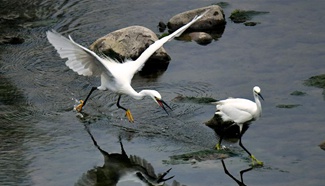WASHINGTON, Oct. 3 (Xinhua) -- U.S. space agency NASA said Monday its Curiosity rover is driving toward uphill destinations on the Red Planet's Mount Sharp as part of its second two-year mission extension that commenced on Oct. 1.
The new destinations included a ridge capped with material rich in the iron-oxide mineral hematite, about two and a half kilometers ahead, and an exposure of clay-rich bedrock beyond that, NASA said.
These are key exploration sites on lower Mount Sharp, which is a 5.5-kilometer-high layered mound where Curiosity is investigating evidence of ancient, water-rich environments that contrast with the harsh, dry conditions on the surface of Mars today, it said.
"We continue to reach higher and younger layers on Mount Sharp," Curiosity Project Scientist Ashwin Vasavada of NASA's Jet Propulsion Laboratory said in a statement. "Even after four years of exploring near and on the mountain, it still has the potential to completely surprise us."
Before setting off towards the new destinations, Curiosity collected drilled rock powder in "arguably the most scenic landscape yet visited by a Mars rover," which is a cluster of mesas and buttes of diverse shapes known as Murray Buttes.
The latest drill site -- the 14th for Curiosity -- is in a geological layer about 180 meters thick, called the Murray formation.
Curiosity has climbed nearly half of this formation's thickness so far and found it consists primarily of mudstone, formed from mud that accumulated at the bottom of ancient lakes, indicating that the lake environment was enduring, not fleeting.
For roughly the first half of the new two-year mission extension, the rover team anticipated investigating the upper half of the Murray formation.
"We will see whether that record of lakes continues further," Vasavada said. "The more vertical thickness we see, the longer the lakes were present, and the longer habitable conditions existed here."
NASA said that it approved Curiosity's second extended mission this summer on the basis of plans presented by the rover team and that additional extensions for exploring farther up Mount Sharp may be considered in the future.
Curiosity landed near Mount Sharp in 2012. It reached the base of the mountain in 2014 after successfully finding evidence on the surrounding plains that ancient Martian lakes offered conditions that would have been favorable for microbes if Mars has ever hosted life.










